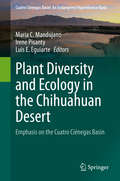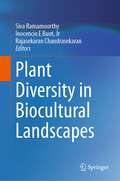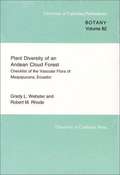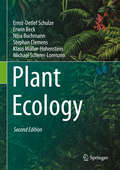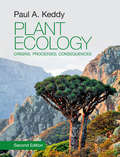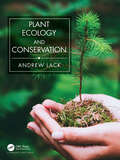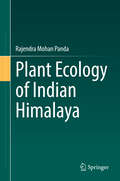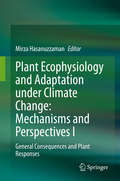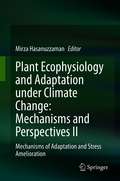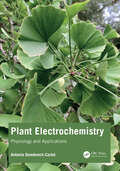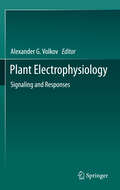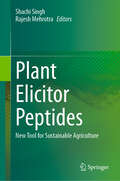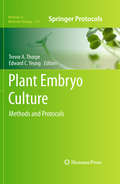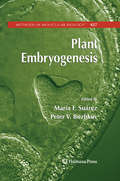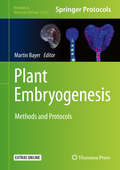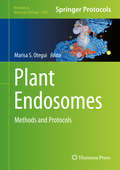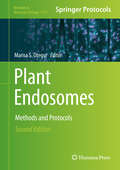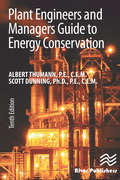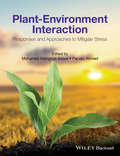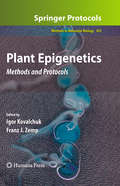- Table View
- List View
Plant Diversity and Ecology in the Chihuahuan Desert: Emphasis on the Cuatro Ciénegas Basin (Cuatro Ciénegas Basin: An Endangered Hyperdiverse Oasis)
by Luis E. Eguiarte Maria C. Mandujano Irene PisantyEnvironmental and specific diversity in the Chihuahuan desert in general, and in the Cuatro Ciénegas Basin in particular, has long been recognized as outstanding. This book provides a global ecological overview, together with in-depth studies of specific processes. The Chihuahuan desert is the warmest in North America, and has a complex geologic, climatic and biogeographical history, which affects today’s distribution of vegetation and plants and generates complex phylogeographic patterns. The high number of endemic species reflects this complex set of traits. The modern distribution of environments, including aquatic and subaquatic systems, riparian environments, gypsum dunes and gypsum-rich soils, low levels of phosphorous and organic matter, and high salinity combined with an extreme climate call for a range of adaptations. Plants are distributed in a patchy pattern based on punctual variations, and many of them respond to different resources and conditions with considerable morphological plasticity. In terms of physiological, morphological and ecological variability, cacti were identified as the most important group in specific environments like bajadas, characterized by high diversity values, while gypsophytes and gypsovagues of different phylogenies, including species with restricted distribution and endemics.
Plant Diversity in Biocultural Landscapes
by Siva Ramamoorthy Rajasekaran Chandrasekaran Inocencio E BuotThe edited book highlights comprehensive studies on plant diversity dynamics, ecosystem processes, and best conservation practices from the interdisciplinary perspectives such as the botanists, ecologists, conservation biologists, geneticists, cell biologists, molecular biotechnologists, and social scientists. The main focus of the book is to address biodiversity loss and ecosystem collapse amidst the escalating climate change problems, aggravated by anthropogenic activities in biocultural landscapes. The book describes the biocultural landscape of today, ecology of plant diversity, botany of keystone and other rare species of economic and pharmaceutical significance, ecosystem processes, conservation, and emerging frameworks to sustain biocultural landscapes in the Anthropocene. Biocultural landscapes are tracks of land in many parts of the world, shaped by unique human-nature interactions. Many of these landscapes are populated with indigenous peoples with a unique way of life including their interaction with plants and the environment. The relationship between humans and nature in biocultural landscapes used to be harmonious. However, as the human population surges, much pressure has been experienced by the landscape, hence, the loss of biodiversity and degradation of ecosystem services that cascade to agricultural systems. The book is of interest to teachers, professors, policymakers, researchers, and advocates in the fields of botany, ecology, taxonomy, biodiversity conservation, environmental science, molecular biology and genomics, molecular ecology, agriculture, and Agri-tourism, forestry, social science, and climate change professionals. Also, the book serves as a good reference and additional reading material for undergraduate and graduate students.
Plant Diversity of an Andean Cloud Forest: Inventory of the Vascular Flora of Maquipucuna, Ecuador
by Grady L. Webster Robert M. RhodeBased on work spanning a decade, this study of the Maquipucuna area on the western slopes of the Andes discusses the climate, vegetation, ecological relationships, and flora, and emphasizes the importance of the Maquipucuna area as a biological reserve. In addition to the checklist of the flora, which enumerates 1,650 species (including 228 species of pteridophytes and over 200 species of orchids), appendices give information on floristic composition of communities, distribution of epiphytes, and elevational ranges of families and genera. The illustrations include a map, landscapes, and characteristic species.
Plant Ecology
by Erwin Beck Ernst-Detlef Schulze Nina Buchmann Stephan Clemens Klaus Müller-Hohenstein Michael Scherer-LorenzenThis completely updated and revised second edition provides a unique and up-to-date treatment of all aspects of plant ecology, making it an ideal textbook and reference work for students, researchers and practitioners. More than 500 high-quality images and drawings, mostly in colour, aid readers’ understanding of various key topics, while the clear structure and straightforward style make it user friendly and particularly useful for students. Written by leading experts, it offers authoritative information, including relevant references. While Plant Ecology primarily addresses graduate students in biology and ecology, it is also a valuable resource for post-graduate students and researchers in botany, environmental sciences and landscape ecology, as well as all those whose study or work touches on agriculture, forestry, land use, and landscape management. Key Topics: - Molecular ecophysiology (molecular stress physiology: light, temperature, oxygen deficiency, water deficit (drought), unfavorable soil mineral conditions, biotic stress) - Physiological and biophysical plant ecology (ecophysiology of plants: thermal balance, water, nutrient, carbon relations) - Ecosystem ecology (characteristics of ecosystems, approaches how to study and how to model terrestrial ecosystems, biogeochemical fluxes in terrestrial ecosystems) - Community ecology and biological diversity (development of plant communities in time and space, interactions between plants and plant communities with the abiotic and the biotic environment, biodiversity and ecosystem functioning) - Global ecology (global biogeochemical cycles, Dynamic Global Vegetation Models, global change and terrestrial ecosystems)
Plant Ecology
by Paul A. KeddyPresenting a global and interdisciplinary approach to plant ecology, this much-awaited new edition of the book Plants and Vegetation integrates classical themes with the latest ideas, models, and data. Keddy draws on extensive teaching experience to bring the field to life, guiding students through essential concepts with numerous real-world examples and full-colour illustrations throughout. The chapters begin by presenting the wider picture of the origin of plants and their impact on the Earth, before exploring the search for global patterns in plants and vegetation. Chapters on resources, stress, competition, herbivory, and mutualism explore causation, and a concluding chapter on conservation addresses the concern that one-third of all plant species are at risk of extinction. The scope of this edition is broadened further by a new chapter on population ecology, along with extensive examples including South African deserts, the Guyana Highlands of South America, Himalayan forests and arctic alpine environments.
Plant Ecology and Conservation
by Andrew LackPlant Ecology & Conservation is an introduction to the world of plant ecology. It includes the main areas of current research including ideas about plant populations, nutrition and plant community ecology and has a particular emphasis on the interactions of plants with animals, fungi and microorganisms whose important is being increasingly demonstrated. With the world’s environmental problems having such a high profile, the book focusses on the human impact on the world’s plant species. Conservation of the terrestrial world starts with plants as they form the basis of all ecosystems on land. We can only understand how best to conserve the world’s biodiversity with an understanding of the central role of plant ecology. This theme runs throughout with numerous examples of the disruption of ecosystems by human activity emphasising the connection between plant ecology and conservation. Key Features: Boxes present case studies, important statistics and interesting asides Full-colour photos depict key species and habitats and superb line drawings illustrate many concepts Important data are presented in Tables and Figures throughout Each chapter has Key Concepts and review questions to test a reader’s grasp of the content Key References and Further Reading are given for each chapter to point the reader towards the most important and influential literature Jargon is kept to a minimum and a full Glossary of all technical terms is presented The book is aimed primarily at undergraduate and graduate students in any aspect of ecology or plant science. It should also appeal to anyone interested in how plants function and are concerned about what is needed for the conservation of the world’s ecosystems.
Plant Ecology in a Changing World
by Russell K. Monson James R. EhleringerToday global changes and human activities affect plants within each of the world’s ecosystems. Plant Ecology in a Changing World provides a foundation for understanding how the changes underway impact structure and function in the world’s major biomes, while also describing how evolution has resulted in the biochemical, physiological, structural, and life history features that shaped plants and their capacities to persist across widely contrasting environments. This textbook is designed for undergraduate students and graduate students as well to serve as a resource for climate change and ecosystem scientists seeking a foundation on the principles of plant ecology and the basis of plant adaptations. While many textbooks focus primarily on natural ecosystems, Plant Ecology in a Changing World also recognizes the ecological importance of invasive, managed, and urban ecosystems and of the ways in which ecosystems are already being impacted by both human activities and a warming planet.Key features: Replete with 450+ figures that help to elucidate concepts and charts to clearly present key data Boxes within chapters allow those who wish to delve into more advanced aspects of topics and of those key methodological approaches used to quantify processes Highlights of key plant ecologists and of their contributions Each chapter concludes with a bulleted summary, enabling students to recap the key points of the chapter Each chapter comes with both a list of references, as well as with suggested readings, allowing the student to expand their knowledge on a particular topic Associated with the book is an array of supplementary materials. These are available and constantly updated at http://plantecology.site.
Plant Ecology of Indian Himalaya
by Rajendra Mohan PandaThis book discusses plant invasions and environmental impacts on the Himalayas through a novel procedure, and helps to understand the influences of climate, physiography, soil, and disturbance on plant richness in mountain systems. Assessing invasion risks to mountain space under future climate change scenarios is highly significant for appropriate preparedness, and this book details analytical and modeling techniques to assess the conditions of mountain ecosystem and ecology to better inform our preparation for future environmental challenges. The book presents the state-of-the-art understanding of the species-environment relationships in a global biodiversity hotspot, relatively unexplored areas for the Himalayan life-form richness. The book provides not only the academic but also the professional community and policymakers a review and update on modeling applications for determining interactions of the plant species with the environment of a subtropical mountain ecosystem across a climatic gradient. Currently, there is no book in the market addressing the implementation and applications of modeling in the Himalayan plant and environment continuum, and most of the existing books cover the species richness pattern along the elevation gradient and basic ethnobotanical features of a mountain system. Since the book covers the applications of novel methods and modeling for ecological analysis of mountain ecosystems, it will also be significant for the professional market. Therefore, the book aims to fill the gap between scientists and professionals in the use of modeling strategies to monitor biodiversity in mountain systems for the formulation of conservation, adaptation, and mitigation principles.
Plant Ecophysiology and Adaptation under Climate Change: General Consequences and Plant Responses
by Mirza HasanuzzamanThis book presents the state-of-the-art in plant ecophysiology. With a particular focus on adaptation to a changing environment, it discusses ecophysiology and adaptive mechanisms of plants under climate change. Over the centuries, the incidence of various abiotic stresses such as salinity, drought, extreme temperatures, atmospheric pollution, metal toxicity due to climate change have regularly affected plants and, and some estimates suggest that environmental stresses may reduce the crop yield by up to 70%. This in turn adversely affects the food security. As sessile organisms, plants are frequently exposed to various environmental adversities. As such, both plant physiology and plant ecophysiology begin with the study of responses to the environment. Provides essential insights, this book can be used for courses such as Plant Physiology, Environmental Science, Crop Production and Agricultural Botany.Volume 1 provides up-to-date information on the impact of climate change on plants, the general consequences and plant responses to various environmental stresses.
Plant Ecophysiology and Adaptation under Climate Change: Mechanisms of Adaptation and Stress Amelioration
by Mirza HasanuzzamanThis book presents the state-of-the-art in plant ecophysiology. With a particular focus on adaptation to a changing environment, it discusses ecophysiology and adaptive mechanisms of plants under climate change. Over the centuries, the incidence of various abiotic stresses such as salinity, drought, extreme temperatures, atmospheric pollution, metal toxicity due to climate change have regularly affected plants and, and some estimates suggest that environmental stresses may reduce the crop yield by up to 70%. This in turn adversely affects the food security. As sessile organisms, plants are frequently exposed to various environmental adversities. As such, both plant physiology and plant ecophysiology begin with the study of responses to the environment. Provides essential insights, this book can be used for courses such as Plant Physiology, Environmental Science, Crop Production and Agricultural Botany.Volume 2 provides up-to-date information on the impact of climate change on plants, the general consequences and plant responses to various environmental stresses.
Plant Electrochemistry: Physiology and Applications
by Antonio Doménech-CarbóThe book comprehensively views the intersection between electrochemistry and botany. It attempts to inform people about the capacity of electrochemistry to provide information of interest to plant science. This includes electrophysiology, plant communication, and plant defense responses, as well as chemoecological and phylogenetic aspects. Conversely, the book also treats the capabilities of vegetal systems and vegetal-derived materials to be used in electrochemical applications for sensing, energy production and storage, and environmental issues.
Plant Electrophysiology
by Alexander G. VolkovThis book compiles new findings from the work of internationally renowned experts in plant electrophysiology, biophysics, bioelectrochemistry, ion channels, membrane transport, imaging of water transport, photosynthesis, mechanosensors, osmotic motors, sensing and actuation in plants. First volume covers modern methods in plant electrophysiology and cell electrophysiology. Second volume deals with signal transduction and responses in plants.
Plant Elicitor Peptides: New Tool for Sustainable Agriculture
by Shachi Singh Rajesh MehrotraThis book provides an overview on plant innate immunity triggered by peptide elicitors. It explains how peptide signals provide protection against phytopathogens and can act as an eco-friendly crop protectant. The chapters in the book deal with identification and characterization of plant elicitor peptides and their receptors, understanding the process of defense activation conferred by peptide signals, methods of isolation and application. Various new techniques and future strategies are discussed for utilization of these immunity inducers. Molecular and functional characterization of the elicitors will be useful in the development of elicitation-based technology, including large scale production and commercialization. This book serves as an essential resource for researchers and industries working in the field of physiology and biotic stress management of crop plants.
Plant Embryo Culture
by Trevor A. Thorpe Edward C. YeungA great fascination for biologists, the study of embryo development provides indispensable information concerning the origins of the various forms and structures that make up an organism, and our ever-increasing knowledge gained through the study of plant embryology promises to lead to the development of numerous useful applications. In Plant Embryo Culture: Methods and Protocols, expert researchers from the field provide a ready source of information for culturing zygotic embryos for different types of studies, both theoretical and practical. The book's main sections examine a wide range of related topics, including the culture of zygotic embryos for developmental studies, the application of embryo culture techniques focusing on embryo rescue methods, cryopreservation of zygotic embryos, the use of zygotic embryos as explants for somatic embryogenesis and organogenesis, as well as transformation protocols using zygotic embryos as starting material. Written in the highly successful Methods in Molecular BiologyTM series format, the detailed chapters include introductions to their respective topics, lists of the necessary materials and reagents, step-by-step, readily reproducible laboratory protocols, and vital notes on troubleshooting and avoiding known pitfalls. Authoritative and convenient, Plant Embryo Culture: Methods and Protocols serves as a key reference that can be used by scientists of all backgrounds to help develop their own customized methods for many different species and for a variety of purposes.
Plant Embryogenesis
by Peter V. Bozhkov Maria Fernanda SuarezStep-by-step reproducible laboratory procedures written by the top experts in the field offering their time-tested hints, tricks, and tips. Presents detailed outlines of embryonic systems models along with cutting-edge cellular, genetic, and molecular mechanism. Provides the most comprehensive collection of protocols on plan embryo development.
Plant Embryogenesis: Methods and Protocols (Methods in Molecular Biology #2122)
by Martin BayerThis volume details state-of-the-art methods for the study of plant embryogenesis in the model organism Arabidopsis thaliana, other models, and non-model species. Chapters guide readers through genetic screens, phenotypic analysis, live imaging, transcriptional profiling, methods on other model and non-model species beyond Arabidopsis thaliana, and introduction to systems that allow to culture or produce zygotic and somatic embryos in vitro. Written in the highly successful Methods in Molecular Biology series format, chapters include introductions to their respective topics, lists of the necessary materials and reagents, step-by-step, readily reproducible laboratory protocols, and tips on troubleshooting and avoiding known pitfalls. Authoritative and cutting-edge, Plant Embryogenesis: Methods and Protocols aims to ensure successful results in the further study of this vital field.
Plant Endosomes
by Marisa S. OteguiPlant Endosomes: Methods and Protocols explores a collection of protocols and techniques to analyze in vivo trafficking of endocytic/endosomal cargo, including lipids, fluids, proteins and ligands, ultrastructural features of endosomes by high-pressure freezing/freeze-substitution and electron tomography, as well as protein-protein interactions in the endosomal and endomembrane system. The volume continues with coverage of the sorting defects in the transport of vacuolar storage proteins, function conservation of plant endosomal proteins, endosomal trafficking during plant responses to pathogens, protein composition of endosomes and endocytic vesicles, ubiquitination of endosomal cargo proteins and the identification of novel endosomal components by chemical genomics and proteomics. Written in the highly successful Methods in Molecular Biology series format, chapters include introductions to their respective topics, lists of the necessary materials and reagents, step-by-step, readily reproducible laboratory protocols and tips on troubleshooting and avoiding known pitfalls. Detailed and practical, Plant Endosomes: Methods and Protocols gathers contributions from many leading and emerging plant membrane trafficking researchers in order to promote and facilitate novel studies and ideas in this vital field.
Plant Endosomes: Methods and Protocols (Methods in Molecular Biology #2177)
by Marisa S. OteguiThis second edition details techniques for the study of cargo trafficking through endosomes. New and updated chapters guide readers through methods and protocols on the structural aspects of plant endosomes, combined biochemical, omics, imaging approaches to study the dynamics and contents of endosomal compartments. Additional chapters are dedicated to the analysis of lipids on endosomes and the identification and analysis of lipid binding proteins and lipid-binding domains relevant for the study of plant endosomes. Written in the highly successful Methods in Molecular Biology series format, chapters include introductions to their respective topics, lists of the necessary materials and reagents, step-by-step, readily reproducible laboratory protocols, and tips on troubleshooting and avoiding known pitfalls. Authoritative and cutting-edge, Plant Endosomes: Methods and Protocols, Second Edition aims to ensure successful results in the further study of this vital field.
Plant Engineers and Managers Guide to Energy Conservation
by Albert Thumann Scott C. DunningCompletely revised and updated, this tenth edition of a bestseller covers both management and technical strategies for slashing energy costs by as much as 40 percent in industrial facilities. It discusses cogeneration, gas distributed generation technologies, steam system optimization, geothermal heat pumps, energy outsourcing, electricity purchasing strategies, and power quality case studies. It also provides guidelines for life cycle costing, electrical system optimization, lighting and HVAC system efficiency improvement, mechanical and process system performance, building energy loss reduction, financing energy projects, and more.
Plant Environment Interaction
by Parvaiz Ahmad Mohamed Mahgoub AzoozThe increase in global population, urbanization and industrialization is resulting in the conversion of cultivated land into wasteland. Providing food from these limited resources to an ever-increasing population is one of the biggest challenges that present agriculturalists and plant scientists are facing. Environmental stresses make this situation even graver. Plants on which mankind is directly or indirectly dependent exhibit various mechanisms for their survival. Adaptability of the plants to changing environment is a matter of concern for plant biologists trying to reach the goal of food security. Despite the induction of several tolerance mechanisms, sensitive plants often fail to withstand these environmental extremes. Using new technological approaches has become essential and imperative. Plant-Environment Interaction: Responses and Approaches to Mitigate Stress throws light on the changing environment and the sustainability of plants under these conditions. It contains the most up-to-date research and comprehensive detailed discussions in plant physiology, climate change, agronomy and forestry, sometimes from a molecular point of view, to convey in-depth understanding of the effects of environmental stress in plants, their responses to the environment, how to mitigate the negative effects and improve yield under stress. This edited volume is written by expert plant biologists from around the world, providing invaluable knowledge to graduate and undergraduate students in plant biochemistry, food chemistry, plant physiology, molecular biology, plant biotechnology, and environmental sciences. This book updates scientists and researchers with the very latest information and sustainable methods used for stress tolerance, which will also be of considerable interest to plant based companies and institutions concerned with the campaign of food security.
Plant Epigenetics
by Igor Kovalchuk Franz J. ZempThe past fifteen years have witnessed major advances in epigenetics, one of the most popular and quickly evolving fields of modern science. In Plant Epigenetics: Methods and Protocols, expert researchers explore the most recent developments, examining in great detail the contribution of epigenetic regulation to cell function in plants. Chapters include a variety of protocols for studying the function of small non-coding RNAs, DNA methylation, and histone modifications in plants, often in different degrees of complexity. This volume describes bioinformatic approaches to the analysis of high-throughput data, such as bisulfite sequencing and Chip-on-chip assays. It features much-desired protocols for plant transgenesis and the analysis of genome stability, with a detailed discussion of their applications to epigenetic studies. Composed in the highly successful Methods in Molecular BiologyTM series format, each chapter contains a brief introduction, step-by-step methods, a list of necessary materials, and a Notes section which shares tips on troubleshooting and avoiding known pitfalls. Wide-ranging and innovative, Plant Epigenetics: Methods and Protocols is an invaluable manual designed to help researchers uncover the undiscovered and unexplained phenomena in plant biology.
Plant Epigenetics
by Igor KovalchukThe discovery of DNA as the genetic material brought great hope to scientists all over the world. It was believed that many of the lingering questions in genetics and the mechanisms of heredity would fnally be answered. However, as often is the case in science, more qu- tions arose out of this discovery. What defnes a gene? What are the mechanisms of gene regulation? Further discovery and technological innovations brought about sequencing techniques that allowed the study of complete genomes from many organisms, including Arabidopsis and humans. Despite all the excitement surrounding these technologies, many features of the genome remained unclear. Peculiar characteristics in genome composition such as signifcant redundancy consisting of many repetitive elements and noncoding sequences, active transcriptional units with no protein product, and unusual sequences in promoter regions added to the mysteries of genetic make-up and gene regulation. Indeed, the more we discovered about the genome, the more diffcult it became to understand the complexity of cellular function and regulation. Out of the study of the intricacies of the genome and gene regulation, arose a new science that was independent of actual DNA changes, but critical in maintaining gene regulation and genetic stability. Epigenetics, literally translated as "above genetics," is the science that describes the mechanisms of heritable changes in gene regulation that does not involve modifcations of DNA sequence. These changes may last through somatic cell division and, in some cases, throughout multiple generations.
Plant Epigenetics and Epigenomics
by Charles Spillane Peter C. MckeownMany fundamental discoveries concerning epigenetics and the elucidation of mechanisms of epigenetic regulation have developed from studies performed in plants. In" Plant Epigenetics and Epigenomics: Methods and Protocols," leading scientists in the epigenetics field describe comprehensive techniques that have been developed to understand the plant epigenetic landscape. These include recently developed methods and techniques for analysis of epigenetically regulated traits, such as flowering time, transposon activation, genomic imprinting and genome dosage effects. Written in the highly successful "Methods in Molecular Biology" series format, chapters include introductions to their respective topics, lists of the necessary materials and reagents, step-by-step, readily reproducible laboratory protocols, and key tips on troubleshooting and avoidance of known pitfalls. Authoritative and practical, "Plant Epigenetics and Epigenomics: Methods and Protocols "seek to aid scientists in the further study of plant epigenetic phenomena using advanced contemporary methods. "
Plant Epigenetics and Epigenomics: Methods and Protocols (Methods in Molecular Biology #2093)
by Charles Spillane Peter McKeownThis second edition volume expands on the previous edition with a look at the latest techniques in plant epigenetics and epigenomic research. Chapters in this book cover topics such as whole genome methylome analysis; analysis of DNA methylation; chromatin analysis of metabolic gene clusters in plants; plant epigenetic stress memory induced by drought; small non-coding RNA analysis in seeds of forest tree species; and a discussion on epigenetics inheritance in plants. Written in the highly successful Methods in Molecular Biology series format, chapters include introductions to their respective topics, lists of the necessary materials and reagents, step-by-step, readily reproducible laboratory protocols, and tips on troubleshooting and avoiding known pitfalls. Cutting-edge and comprehensive, Plant Epigenetics and Epigenomics: Methods and Protocols, Second Edition is a valuable resource for both novice and expert researchers, and aims to advance this field of study by paving the way for integrating epigenetic mechanisms into models of plant function during development and evolution.
Plant Essential Oils: From Traditional to Modern-day Application
by Nawal Kishore Dubey Bhanu Prakash Jackline Freitas Brilhante de São JoséThis book is a comprehensive collection of information on essential oils and their industrial application. It provides reader with a systematic and advanced knowledge of the role of essential oils as natural preservatives and therapeutic agents. Food and pharmaceuticals are two important pillars of human civilization. Plant essential oils and their volatile compounds have been used for preservation as well as for the treatment of human illness for long as traditional practices in biodiversity-rich countries. This book deals with the potential uses of essential oils against insect pests and spoilage microbes of agri-food commodities such as pulses, cereal, fruits, and their shelved products. It also highlights the molecular-assisted engineering of plant essential oils, the pharma-kinetic facet, and their potential in pharmaceutical and aromatherapy. In addition, the book covers recent advances in science and technology such as extraction methods, metabolomics, phytochemical genomics, bioinformatics, conformational dynamics, mathematical modeling, and nanotechnology application. This book is of interest to teachers, researchers, food scientists, capacity builders, and policymakers. Also, it serves as an additional reading material for undergraduate and postgraduate students of agriculture, food, and pharmaceutical sciences.
